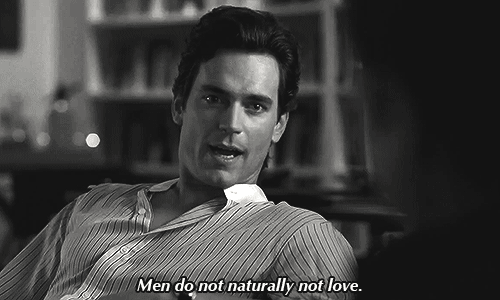Ryan Murphy’s HBO film, The Normal Heart, depicts the story of the Gay Men’s Health Crisis (GMHC) and the beginning of the AIDS epidemic in New York City. The film begins with as many possible stereotypes of gay men as one can think of, displayed when  Ned leaves the boat to attend birthday celebrations for Craig, the current lover of Bruce Niles. Men wearing skimpy clothing, as discussed in Erving Goffman’s Codes of Gender – their actions and poses were not “natural” and they shared the same subject audience and embodiment of assumptions of desire (what men want): Fire Island Pines was full of the male gaze towards men and the return of the gaze.
Ned leaves the boat to attend birthday celebrations for Craig, the current lover of Bruce Niles. Men wearing skimpy clothing, as discussed in Erving Goffman’s Codes of Gender – their actions and poses were not “natural” and they shared the same subject audience and embodiment of assumptions of desire (what men want): Fire Island Pines was full of the male gaze towards men and the return of the gaze.
Craig is the first individual that dies of AIDs in the film. Bruce (Taylor Kitsch) shows off his new military ranking when Ned and the other guests enter his house – Bruce embra ces his homosexuality on the beach island full of gay men, but lives in the closet when he returns to reality in New York City. Stereotypes of military men: rigid, manly, strong, masculine (alternatively, in Judith Lorber’s article, Marine women were expected to wear makeup and take classes on hair care, poise and etiquette to ensure that women were differentiated in a male-dominated organization). Bruce is not a feminine man, but he initially resists being recognized as the gay president of the GMHC on mass media. In an interview with Kitsch, he is asked about this military position (which also states that openly gay men are now allowed to serve in the military) and he says, “Let’s put it quite simply: Are you going to be questioning the sexuality of the guy next to you in the trenches if he’s giving you CPR, going to save your life with a tourniquet, or is pulling you to safety? I think that answers its own question.”
ces his homosexuality on the beach island full of gay men, but lives in the closet when he returns to reality in New York City. Stereotypes of military men: rigid, manly, strong, masculine (alternatively, in Judith Lorber’s article, Marine women were expected to wear makeup and take classes on hair care, poise and etiquette to ensure that women were differentiated in a male-dominated organization). Bruce is not a feminine man, but he initially resists being recognized as the gay president of the GMHC on mass media. In an interview with Kitsch, he is asked about this military position (which also states that openly gay men are now allowed to serve in the military) and he says, “Let’s put it quite simply: Are you going to be questioning the sexuality of the guy next to you in the trenches if he’s giving you CPR, going to save your life with a tourniquet, or is pulling you to safety? I think that answers its own question.”
Ruth Hubbard discusses how sexuality is socially constructed and mentions that “behaviour stopped being attributed to particular persons and came to define them” and that “same-sex love into a medical problem to be treated by doctors rather than punished by judges”. This is reinforced in The Normal Heart when Emma first addresses the large group of men and tells them about the disease that is beginning to spread, encouraging them to abstain from sexual relations to prevent spreading the disease. The outrage stereotypes gay men as promiscuous, when they are not always thinking about having sex all the time.
into a medical problem to be treated by doctors rather than punished by judges”. This is reinforced in The Normal Heart when Emma first addresses the large group of men and tells them about the disease that is beginning to spread, encouraging them to abstain from sexual relations to prevent spreading the disease. The outrage stereotypes gay men as promiscuous, when they are not always thinking about having sex all the time.
The fact that a woman is an authority figure reverses the socially constructed dichotomy and makes it hard for the men to take a straight woman seriously (because how would a woman know about the spread of AIDs in gay men?). Emma’s character, a female doctor in a wheelchair, undermines many stereotypes as a doctor (a profession that allowed men to “dominate the positions of authority”) and researcher of a disease not taken seriously in society (Lorber). Her search for an answer and hope to treat or cure AIDs reflects her struggle with polio.
Ned leads the initiative to publicize and raise awareness for AIDs, which was not well received – why should mass media promote an illness that affects anyone other than the white, heterosexual, non-drug user? Ned asks his brother, Ben, to acknowledge him as an equal and his (slightly homophobic) brother struggles to, here we see society reflected in Ben – breaking the Christian ideals of sexuality meaning sex for procreation
.

 In Ned’s attempt to have TIME magazine publish information on AIDS, he falls in love with writer Felix Turner. The two writers are passion in raising awareness of the crisis. In the extremely tear-jerking scene where Emma marries Felix and Ned, this defies all the laws at the time (gay marriages being legal is a pretty recent allowance) and is summed up nicely by Hubbard who says that “people fall in love with individuals, not a sex”.
In Ned’s attempt to have TIME magazine publish information on AIDS, he falls in love with writer Felix Turner. The two writers are passion in raising awareness of the crisis. In the extremely tear-jerking scene where Emma marries Felix and Ned, this defies all the laws at the time (gay marriages being legal is a pretty recent allowance) and is summed up nicely by Hubbard who says that “people fall in love with individuals, not a sex”.
Until Tommy’s Rolodex pages were displayed at the end of the film (a huge stack of lost men) and the results of the lack of action showed the critical number of deaths due to AIDS, the effects of the disease did not appear real to medical professionals and society.



Hopefully, with progress continuing the way it is today, situations like that reflected in the film (a large group being dismissed because they are not considered the ‘norm’) do not continue to occur. A person should not be defined by their sexuality – no person’s blood is redder than any other person and society should continue its path to equality for men and women and their choices in gender identity and sexuality.
